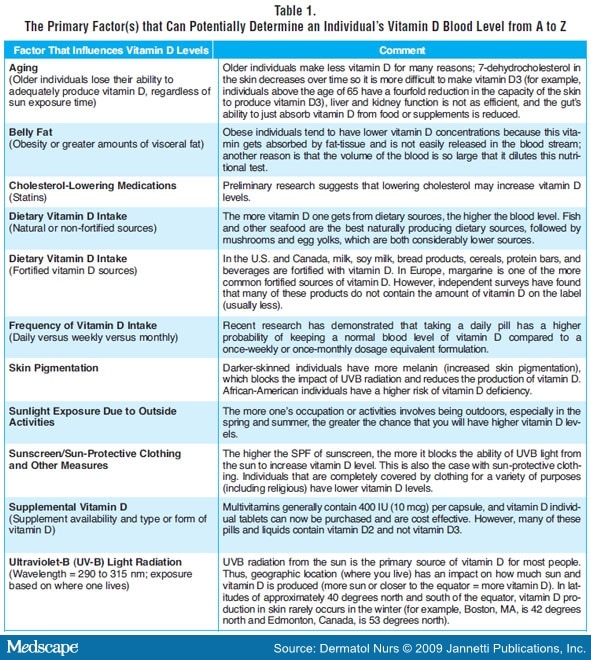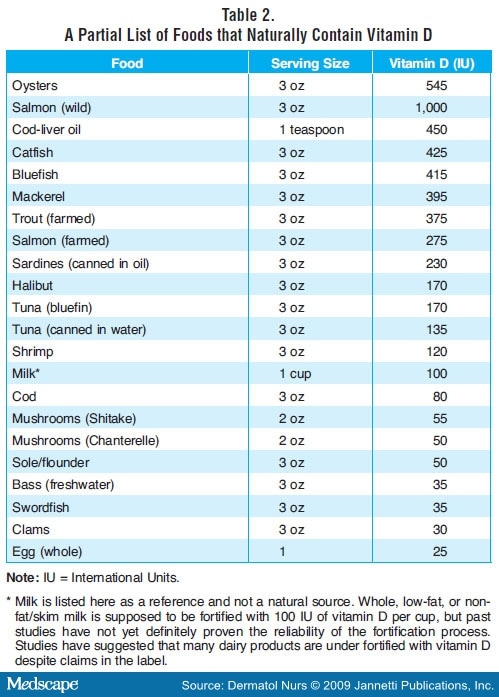Vitamin D2 and/or Vitamin D3
There are two types of vitamin D supplements available for over-the-counter purchase (vitamin D2 and vitamin D3). Vitamin D3 is the type that most experts believe should be utilized in clinical practice (Wolpowitz & Gilchrest, 2006). Vitamin D2 is also known as "ergocalciferol," and vitamin D3 is also known as "cholecalciferol." This is important for patients who have purchased a dietary supplement that does not indicate the specific type of vitamin D in the product by number but have listed the scientific name. Most experts now believe that the only form that should be purchased is vitamin D3. Vitamin D2 is also very acceptable, but in the author’s opinion, most individuals should switch to D3. There is a plethora of logical reasons for advocating the use of vitamin D3 over vitamin D2 dietary supplements (Wolpowitz, & Gilchrest, 2006), including:
UVB light from the sun strikes the skin, and humans synthesize vitamin D3, so it is the most "natural" form. Human beings do not make vitamin D2, and most healthy fish contain vitamin D3.
Vitamin D3 is the same price as vitamin D2.
Vitamin D3 may be less toxic than D2 because higher concentrations of D2 circulate in the blood when consumed (compared to vitamin D3). It does not bind as well to the receptors in the human tissues compared to vitamin D3.
Vitamin D3 is the more potent form of vitamin D, which is a potential benefit. For example, obesity tends to lower blood levels of vitamin D, so a more potent form is needed.
Vitamin D3 is more stable on the shelf compared to D2, and is more likely to remain active for a longer period of time and when exposed to different conditions (temperature, humidity, and storage). This is perhaps why the amount of vitamin D2 in certain fortified food products have been significantly lower than that advertised on the label in numerous instances.
Vitamin D3 has been the most utilized form of vitamin D in clinical trials, and there have only been a few clinical trials of vitamin D2 to prevent bone fractures in adults.
Vitamin D3 is more effective at raising and maintaining the vitamin D blood test (again, D2 binds less tightly to the vitamin D receptors in the body; therefore, D2 does not circulate as long in the body, which means it has a shorter half-life).
Vitamin D2 is a fungus/yeast-derived product, and it was first produced in the early 1920s by exposing foods to ultraviolet light (Wolpowitz & Gilchrest, 2006). This process was patented and licensed to pharmaceutical companies. Currently, many major prescription forms of vitamin D are actually vitamin D2 and not vitamin D3. Vitamin D2 is synthetically made from radiating a compound (ergosterol) from the mold ergot. Vitamin D3 is made commercially and synthetically in a similar way that it is produced intrinsically in human and animal skin when exposed to UVB light. Wool sources of 7-dehydrocholesterol are used (from cholesterol), and irradiatied to form active vitamin D3. Vegetarians or especially vegans may be opposed to the use of vitamin D3 supplementation because it is derived from an animal source, and these individuals should be guided to the vitamin D2 form. Multivitamins have either vitamin D2 or D3, but many companies are now utilizing mostly vitamin D3. Cod liver oil has vitamin D3 in it.
Rickets, a defect in bone growth in infancy and childhood, was first identified in 1650 (Welch, Bergstrom, & Tsang, 2000). It was not until 1922 that medical research demonstrated that something in cod liver oil prevented and cured rickets. Additionally, vitamin D2 added to milk in the United States and Europe in the 1930s essentially eliminated rickets (disease of weak bones in children) or osteomalacia (same disease of weak bones but in adults). Currently, fortification with vitamin D2 or D3 has continued to keep rickets scarce in North America. The minimum amount of vitamin D needed to prevent rickets is 100 IU (2.5 mcg) per day in infants with little to no sun exposure.
Dermatology Nursing. 2009;21(1) © 2009 Jannetti Publications, Inc.
Cite this: Vitamin D: A Rapid Review - Medscape - Jan 01, 2009.








Comments